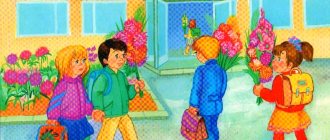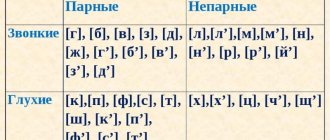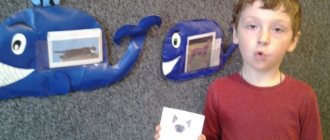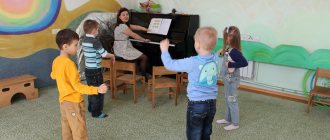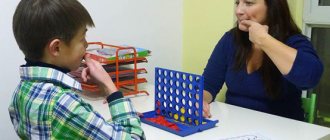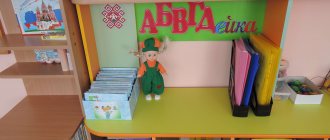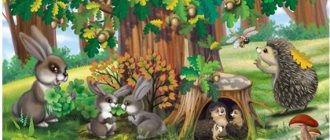Lessons on learning to write, teaching the alphabet, assignments . Lessons for future first-graders. Guides for parents and teachers:
- Literacy games for children 5–6 years old in kindergarten
- Educational games for children in the senior group of kindergarten
- Games for teaching literacy to senior preschoolers
Game “Find out who makes what sounds?”
Goal : develop auditory perception.
Game material and visual aids: a set of subject pictures (beetle, snake, saw, pump, wind, mosquito, dog, locomotive).
Description: the teacher To the question “How does a saw ring, a beetle buzz, etc.” the child answers, and all children reproduce this sound.
Game "Whose voice?"
Goal : develop auditory perception.
Description: the driver If the driver guesses it, the specified child becomes the driver.
Sample material:
• We'll play a little while you listen and find out.
Try to guess who called you, find out. (Name of the driver.)
• A cuckoo flew into our garden and was singing.
And you, (driver’s name), don’t yawn, guess who’s crowing!
Cuckoo!
• The rooster sat on the fence and crowed throughout the yard.
Listen, (driver’s name), don’t yawn, find out who our rooster is!
Ku-ka-riku!
Game "Guess the Sound"
Goal : to practice clarity of articulation.
Description: the presenter Children guess the sound by the movement of the presenter's lips and pronounce it out loud. The first one to guess becomes the leader.
Game “Who has good hearing?”
Goal : develop phonemic awareness, the ability to hear sounds in words.
Game material and visual aids: a set of subject pictures.
Description: the teacher Children clap their hands if they hear the sound they are studying in the name. At later stages, the teacher can silently show the picture, and the child pronounces the name of the picture to himself and reacts in the same way. The teacher marks those who correctly identified the sound and those who could not find it and complete the task.
Game “Who Lives in the House?”
Goal : develop the ability to determine the presence of sound in a word.
Game material and visual aids: a house with windows and a pocket for laying out pictures, a set of subject pictures.
Description: the teacher We need to put these animals in a house. Children name all the animals depicted in the pictures and choose among them those whose names contain the sound [l] or [l']. Each correctly chosen picture is scored with a game chip.
Approximate material: hedgehog, wolf, bear, fox, hare, elk, elephant, rhinoceros, zebra, camel, lynx.
Game "Who is bigger?"
Goal : develop the ability to hear the sound in a word and relate it to the letter.
Game material and visual aids: a set of letters already known to children, object pictures.
Description: Each The teacher shows the picture, the children name the depicted object. The chips are received by the one who hears the sound corresponding to his letter. The one with the most chips wins.
Game "Helicopter"
Goal : develop the ability to select words starting with a given sound.
Game material and visual aids: two plywood disks superimposed on each other (the lower disk is fixed, letters are written on it; the upper disk rotates, a narrow sector, the width of a letter, is cut out of it); chips.
Description: Children The child must name the word starting with the letter where the slot sector stops. The one who completes the task correctly receives a chip. At the end of the game, the number of chips is counted and the winner is determined.
Game "Logo"
Goal : develop the ability to isolate the first sound in a syllable and correlate it with a letter.
Game material and visual aids: a large lotto card, divided into four squares (three of them contain images of objects, one square is empty) and cover cards with the studied letters for each child; for the presenter a set of separate small cards with images of the same objects.
Description: The presenter The child, who has this picture on the lotto card, names the object and the first sound in the word, and then covers the picture with the card of the corresponding letter. The first one to cover all the pictures on the lotto card wins.
Approximate material: stork, duck, donkey, tail, catfish. rose, lamp, etc.
Game "Chain"
Goal : develop the ability to identify the first and last sounds in a word.
Description: one The next child of the row continues, etc. The task of the row is not to break the chain. The game can be played as a competition. The winner will be the row that “pulled” the chain the longest.
Game “Where is the sound hidden?”
Goal : develop the ability to establish the place of sound in a word.
Game material and visual aids: the teacher has a set of subject pictures; Each child has a card divided into three squares and a colored chip (red with a vowel, blue with a consonant).
Description: the teacher Children repeat the word and indicate the location of the sound being studied in the word, covering one of the three squares on the card with a chip, depending on where the sound is located: at the beginning, middle or end of the word. Those who correctly place the chip on the card win.
Game "Where is our home?"
Goal : develop the ability to determine the number of sounds in a word.
Game material and visual aids: a set of subject pictures, three houses with pockets and a number on each (3, 4, or 5).
Description: children The child takes a picture, names the object depicted on it, counts the number of sounds in the spoken word and inserts the picture into a pocket with a number corresponding to the number of sounds in the word. Representatives of each team come out in turn. If they make a mistake, they are corrected by the children of the other team. For each correct answer, a point is counted, and the row whose players score the most points is considered the winner. The same game can be played individually.
Approximate material: lump, ball, catfish, duck, fly, crane, doll, mouse, bag.
Game "Wonderful bag"
Goal : develop the ability to divide words into syllables.
Game material and visual aids: a bag of colorful fabric with various objects, the names of which have two or three syllables.
Description: children The word is repeated syllable by syllable. The child names the number of syllables in a word.
Game "Telegraph"
Goal : develop the ability to divide words into syllables.
Description: the teacher I will name the words, and you will transmit them one by one by telegraph to another city.” The teacher pronounces the first word syllable by syllable and accompanies each syllable with clapping. Then he names the word, and the called child independently pronounces it syllable by syllable, accompanied by clapping. If a child completes the task incorrectly, the telegraph breaks down: all the children begin to slowly clap their hands; a damaged telegraph can be repaired, that is, pronounce the word correctly syllable by syllable and clap.
Alphabet in pictures for children
Alphabet letter coloring pages for preschool and primary school age children.
Learning any language begins with becoming familiar with the alphabet. How to introduce a child to the alphabet? Of course, with the help of beautiful and educational pictures. With our ABC coloring book, getting to know the alphabet will become an enjoyable and memorable game for your children.
Each coloring page contains a drawing of a letter, its spelling, as well as pictures of animals and objects that begin with this letter.
While coloring pictures, children will name objects and pronounce letters constantly.
These educational letter coloring pages will be an excellent springboard for in-depth study of the Russian language in the future.
These didactic materials will be useful for educators, teachers, and parents for joint activities with children.
Riddles are useful for learning the alphabet: Letters of the alphabet. You can solve these riddles to reinforce the letters of the alphabet.
Benefits of classes:
- These classes will enable the child to better acquire knowledge about the variety of sounds and letters;
- will form ideas about words and that words consist of sounds;
- will be a good assistant in the formation of phonemic hearing (the ability to hear and distinguish sounds in speech);
- With the help of adults, children will learn to distinguish sounds in speech, and therefore pronounce them correctly.
- Completing these tasks will help prepare children for learning to read and write in the senior group of kindergarten and in preparation for school.
Each lesson is located on 2 sheets of A4 format. You can print on two sheets, or on one - a page on each side. Total, 50 sheets - 50 full-fledged lessons on developing the pronunciation side of speech and teaching literacy.
The classes are developed based on our website. On the site you will find colorful illustrations, games and exercises to help with the printouts.
Instructions included.
Each lesson contains detailed instructions on how to complete the tasks. Tasks include: a description of the sound being studied, a graphic representation of a letter, a copy of letters, many illustrations of sounds and other interesting material.
In order for the child to find it both interesting and useful at the same time, the classes are supplemented with numerous coloring books . This is both visibility for the child and the development of fine motor skills of the fingers . Let us remind you that it is better to color with triangular pencils: they fit better in the child’s fingers.
Letters A, B, C, D, D, E, E, F
Literacy cards
Each exercise consists of a short sentence and five tasks required to complete. A sentence is a short text. There are usually no problems with reading and understanding it. Sentence texts are not repeated; they are easy to come up with yourself.
The question is often asked: why repeat a sentence you read? Children who are beginning to read concentrate on the reading process itself, poorly understanding the content. Setting the stage for repetition after reading helps, from our point of view, to include understanding of the text.
The first time you need to do the exercise together. And then be sure to check the correctness of execution and sort out errors (if any). This is another plus: you learn the techniques of independent work. The longest word is determined by the number of letters.
The card looks like this.
In any editor, you can change the sentence, leaving the assignments. Get a new card. For example.
Lisa drew a picture.
Exercise.
1. Read the sentence and repeat it out loud.
2. Copy the longest word
3. Count how many words are in the sentence and write it in the empty square.
4. Divide the words into syllables.
5. In each word, place a red dot with a felt-tip pen under the vowels, a blue dot under the hard consonants, and a green dot under the soft consonants.
Example of completing a (partial) task
Letters Z, I, J, K, L, M, N, O
Definition of the term
Grammar is part of the science of one’s native language, and by becoming familiar with it, a child learns to write and speak correctly and construct sentences without errors. Such activities form intelligence, develop imagination and memory, and help the child’s speech become imaginative, expressive and, most importantly, more literate.
In addition, exercises help develop the following categories of skills in children:
- development of “linguistic flair” - the ability to intuitively understand and use the norms of the Russian language;
- phonetic hearing - determine by ear whether a certain word has a specific sound;
- enrichment of active and passive vocabulary;
- development and improvement of coherent speech;
- the ability to coordinate words when constructing a phrase;
- the ability to divide words into syllables.
Also, regular classes will help improve children’s logical thinking, their ability to find a way out of an unusual situation, attention and memory in a playful way.
Letters P, R, S, T, U, F, X, C
Best age
Experts recommend literacy lessons for preschoolers starting at age 5. Of course, at an earlier age you can perform several simple exercises, which will become a kind of preparatory step, but serious and targeted training, learning the basics of reading and writing should begin precisely in the older preschool age - at this time children are especially receptive to this information.
At the age of 5-6, you can teach children to read and write; for this, you should use a variety of tasks and role-playing games that make it possible to turn the process of acquiring new knowledge into an exciting pastime.
Teaching preschoolers to read and write must be interesting for them; you cannot force a child to pore over copybooks “under pressure”, otherwise he will develop a sharply negative attitude towards learning new things for the rest of his life.
Letters Ch, Sh, Shch, b, ы, b, e, yu, ya
Lesson Rules
Whatever the grammar lesson, be it familiarization with the phonemic composition of a word, working with letters and sounds, teaching writing, it is important for parents to use a game form. Sometimes fun and interest become even more important than the theoretical aspect. It is necessary to structure the home “lesson” in such a way that the child makes sure to make his own small discovery. He will have self-confidence, pride, and a desire to learn further, and this is often much more important than mindlessly memorizing the alphabet.
To achieve this goal, various gaming technologies can be used.
- Journey. The parent figures out in advance what magical land the trip will be made to and what stops will be made. For example, if it is necessary to teach a child to correctly form a comparative degree in oral speech, then the stops can be fruits and vegetables (compare: a large watermelon, and a smaller apple).
- Puzzles. The following plot is played out - in order to get something from the fairy-tale hero, we need to help him solve several riddles on the topic. For example, conduct a sound analysis of a simple word.
- Working with illustrations. Compiling a coherent story, completing the drawing, answering questions based on the picture.
- Working with objects. It is easier for children to perceive information if they see what is being said. Therefore, when studying adjectives with them, you should definitely use a certain object (it could be a ball) for which you will need to come up with characteristics.
It is not necessary to turn every literacy lesson for preschool children into a kind of carnival with music and costumes. But all lessons should be conducted on a positive wave and be a joy for the child.
Junior group. Early childhood, nursery. Children 1-4 years old
Lesson on the sound culture of speech “Sound [u]” (junior group) Topic: Sound “u”
Goal:
teaching children to clearly articulate the sound “oo-oo-oo”
.
Objectives: - educational: learn to pronounce the sound “u”
with different volumes, by imitation;
consolidate the ability to clearly pronounce the sound “u”
on one exhalation. - developing: develop auditory perception,...
Summary of the lesson “Sound culture of speech: sound [f]” with children 3–4 years of age
Goal: to practice clear pronunciation
of the sound “f”
isolated, as well as
onomatopoeia in words. Objectives : Educational: • To develop in children the need to clearly pronounce the sound and onomatopoeic words with this sound ; • Form intonation in children...
